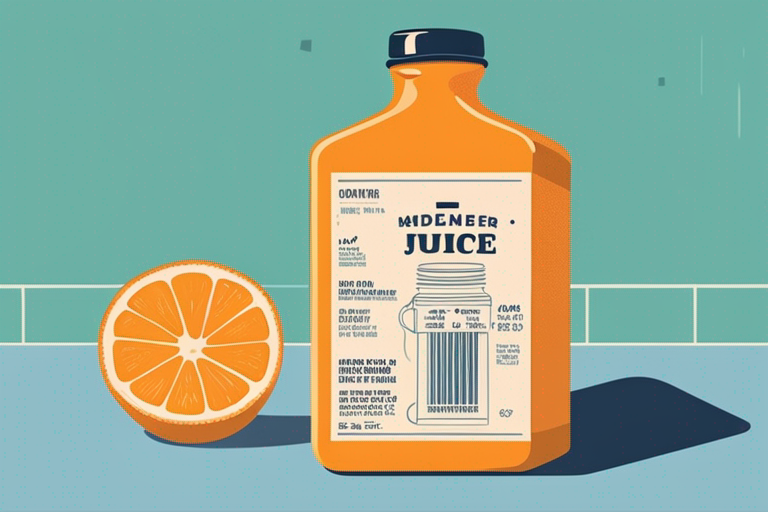
Understanding Minute Maid Orange Juice Expiration Date and Location
Get Your Free Food Safety Cheat Sheet
30 most common foods with instant answers. Print it and stick it on your fridge—completely free!
# Understanding Minute Maid Orange Juice Expiration Date and Location
## Understanding Minute Maid Orange Juice Expiration Date and Location
When it comes to ensuring food safety and quality, understanding the expiration date of products is crucial. In the case of Minute Maid orange juice, knowing where to find the expiration date on the packaging can help you determine the freshness and safety of the product. In this comprehensive guide, we will delve into how to locate the expiration date on Minute Maid orange juice containers, why it's important, and essential tips for proper storage to maintain its quality. ([Orange juice](https://canieatexpired.com/food/orange-juice))
## Importance of Checking the Expiration Date
Checking the expiration date on food products, including Minute Maid orange juice, is essential for several reasons:
1. **Safety**: Consuming expired orange juice can pose health risks due to potential spoilage and bacterial growth.
2. **Quality**: Freshness and taste can significantly deteriorate past the expiration date.
3. **Nutritional Value**: Expired orange juice may have reduced nutritional content.
## Where to Find the Expiration Date on Minute Maid Orange Juice
Minute Maid typically prints the expiration date on their orange juice packaging for easy reference. Here's where you can commonly find it:
### On the Cap or Lid
1. Look for a printed date on the cap or lid of the Minute Maid orange juice container.
2. The expiration date is often located on the top of the cap in a clearly visible format.
### On the Side or Bottom of the Container
1. Check the side or bottom of the Minute Maid orange juice carton or bottle for the expiration date.
2. The date is usually printed in a designated area with clear labeling.
### Julian Date Code
1. Some Minute Maid products may use a Julian date code for expiration dating.
2. The Julian date code is a numerical representation of the date, with the first three digits indicating the day of the year and the last digit representing the year.
## Tips for Proper Storage of Minute Maid Orange Juice
Proper storage is key to maintaining the freshness and quality of Minute Maid orange juice. Follow these tips to ensure optimal storage conditions:
### Before Opening
1. **Refrigeration**: Store unopened Minute Maid orange juice in the refrigerator to prolong its shelf life.
2. **Temperature**: Keep the juice at a consistent temperature of 40°F (4°C) or below.
3. **Avoid Sunlight**: Store the juice away from direct sunlight or heat sources.
### After Opening
1. **Seal Properly**: Ensure the container is tightly sealed after opening to prevent contamination and maintain freshness.
2. **Refrigeration**: Refrigerate opened orange juice and consume it within the recommended timeframe for best quality.
3. **Use Glass Containers**: Consider transferring leftover juice to a glass container with a tight seal for extended freshness.
### General Tips
1. **Check for Signs of Spoilage**: Discard Minute Maid orange juice if you notice any off smells, flavors, or mold growth.
2. **Follow Storage Instructions**: Adhere to any specific storage guidelines provided on the packaging for optimal quality.
3. **Rotate Stock**: Use the oldest orange juice first to prevent expiration and waste.
## Real-Life Scenarios: When Expiration Dates Matter
Imagine it's a hot summer day, and you decide to whip up a refreshing breakfast. You head to the fridge, grab a carton of Minute Maid orange juice, and suddenly remember that you were unsure about the expiration date. You check the carton, and to your relief, it’s still fresh! Enjoying that cold glass of juice not only cools you down but also gives you a boost of vitamin C.
Conversely, picture this: You’re hosting a brunch with friends, and while preparing mimosas, you pour out the orange juice from a carton that you unknowingly kept for weeks past its expiration date. The taste is off, and you end up with a sour start to your gathering. This scenario highlights the importance of checking expiration dates—not just for safety but for the enjoyment of the product!
Now, consider a busy mom who rarely checks the date on juice cartons. In her rush, she uses a carton of Minute Maid orange juice to make her kids smoothies for breakfast. Later, they complain of upset stomachs. This situation underscores the importance of being vigilant about expiration dates, especially when serving food to children.
Another relatable story involves a college student who buys a carton of Minute Maid orange juice at the start of the semester but forgets about it in the back of the fridge. When he finally discovers it weeks later, he’s unsure if it’s still safe to drink. This emphasizes the need to not only check the expiration date but also remain aware of what’s in your fridge!
## Scientific Context: The Importance of Shelf Life
Understanding the science behind shelf life can help you appreciate the expiration date on Minute Maid orange juice. Pasteurization is a common process used in juice production, which kills harmful bacteria and extends shelf life. However, once the juice is opened, the barrier of safety diminishes.
Without proper storage, juices, even those that are pasteurized, can become breeding grounds for bacteria. Nutritional compounds such as vitamin C can degrade over time, particularly when exposed to light and air. This degradation means that not only does the juice taste worse, but it may also offer diminished health benefits.
In addition, research shows that once juice is exposed to oxygen, oxidation can occur, which not only affects flavor but may also reduce the juice's health-promoting properties. Understanding these factors can empower consumers to make informed choices about the juice they consume.
## Expert Insights: Recommendations from Food Safety Authorities
Food safety experts recommend that consumers not only pay attention to expiration dates but also familiarize themselves with the concept of “best by” dates versus “use by” dates. The “best by” date refers to the period when the product is expected to be at its peak quality. This date may be more flexible than the “use by” date, which indicates when the product should no longer be consumed for safety reasons.
Additionally, it's wise to consult food safety resources, such as the USDA or FDA, for guidance on food handling and storage practices. These organizations emphasize the importance of minimizing food waste while ensuring safety, which is crucial in today’s world.
## Common Mistakes When Dealing with Juice Expiration Dates
Many people aren’t aware of certain common pitfalls when it comes to checking and interpreting expiration dates. Here are a few:
1. **Ignoring Dates**: Some assume that juice is good indefinitely as long as it looks and smells fine. Spoilage can occur without obvious signs.
2. **Not Rotating Stock**: Failing to place newer cartons behind older ones can result in older juice going unnoticed and eventually spoiling.
3. **Misinterpreting Julian Codes**: Not everyone is familiar with Julian date codes, which may lead to confusion about freshness.
Furthermore, another common mistake is assuming that juice can be stored at room temperature indefinitely. Many consumers are unaware that even unopened juice should ideally be kept refrigerated to ensure its safety and quality.
## Practical Tips for Enjoying Your Minute Maid Orange Juice
To get the most out of your Minute Maid orange juice, consider these additional actionable tips:
1. **Freeze for Later**: If you have leftover juice that you won’t consume in time, freeze it in ice cube trays for easy use in smoothies or other recipes. You can pop a few cubes into a blender for a refreshing drink or use them to chill other beverages without diluting them.
2. **Mix it Up**: Use your juice in marinades or salad dressings for an added burst of flavor. Fresh orange juice can elevate dishes and bring zest to your cooking. For instance, combine it with olive oil and herbs to create a vibrant salad dressing.
3. **Stay Organized**: Keep a food inventory list on your fridge. Note expiration dates to avoid surprises and plan meals around ingredients that need to be used soon. This practice can help reduce food waste and ensure you always have fresh ingredients on hand.
### Storage Methods for Optimal Freshness
While we’ve covered some general storage tips, here are a few detailed methods for ensuring your Minute Maid orange juice stays fresh longer:
- **Use Airtight Containers**: If you’ve opened a carton, transferring the juice to an airtight container can help block out light and air, both of which contribute to spoilage and oxidation.
- **Keep It Cold**: When transporting Minute Maid orange juice, use an insulated cooler bag with ice packs to maintain a low temperature. This is especially important during picnics or road trips.
- **Label Containers**: If you decide to freeze juice or transfer it to another container, label it with the date of storage. This helps you to keep track of how long it has been stored and when it should be used.
### Conclusion
Being aware of the expiration date and storage practices for Minute Maid orange juice is essential for ensuring both safety and quality. By checking the expiration date on the packaging and following proper storage guidelines, you can enjoy fresh and delicious orange juice every time. Remember to refrigerate the juice, seal it tightly, and consume it within the recommended timeframe for the best taste experience. Stay informed, stay safe, and savor the goodness of Minute Maid orange juice responsibly.
For more information on orange juice and other food safety tips, visit our [orange juice](/food/orange-juice) section. ([Orange juice](https://canieatexpired.com/food/orange-juice))
## Related Posts
Here are some other articles you might find helpful:
- [Can I Drink Expired Orange Juice?](/blog/can-i-drink-expired-orange-juice)
- [The Ultimate Guide to Orange Juice Expiration Date](/blog/orange-juice-expiration-date)
- [How Long Does Orange Juice Last After the Expiration Date?](/blog/how-long-does-orange-juice-last-after-expiration-date)
- [The Ultimate Guide to Fruit Juice Shelf Life](/blog/fruit-juice-shelf-life)
- [Is Expired Orange Juice Still Safe to Drink?](/blog/how-long-after-expiration-date-is-orange-juice-good)

Authoritative Food Safety References
These agencies and university labs inform every tip and health precaution we publish.
USDA FoodKeeper – Cold Storage Guidelines
Official refrigerator, freezer, and pantry timelines maintained by the U.S. Department of Agriculture.
Visit USDA FoodKeeperFDA Produce Safety Rule & Grower Guidance
Field-to-fridge handling practices that prevent contamination of fruits, vegetables, and leafy greens.
Visit FDA Produce SafetyCDC Foodborne Illness Prevention Hub
Surveillance-backed guidance on pathogens, symptoms, and steps to reduce foodborne illness risk.
Visit CDC Food SafetyUC Davis Postharvest Technology Center
University research detailing optimal storage atmospheres for produce after harvest.
Visit UC Davis PostharvestPenn State Extension – Home Food Preservation & Safety
Peer-reviewed extension bulletins on safe canning, chilling, and reheating practices.
Visit Penn State ExtensionHow can I tell if Minute Maid Orange Juice has gone bad?
Can Minute Maid Orange Juice be consumed after the expiration date?
How should Minute Maid Orange Juice be stored to prolong its shelf life?
Is Minute Maid Orange Juice safe to drink if it has been left out of the refrigerator for a few hours?
Get Your Free Food Safety Cheat Sheet
30 most common foods with instant answers. Print it and stick it on your fridge—completely free! Want more? Upgrade to the complete guide with 70+ foods.
Scan your food directly and get instant safety info using our AI-powered camera feature.